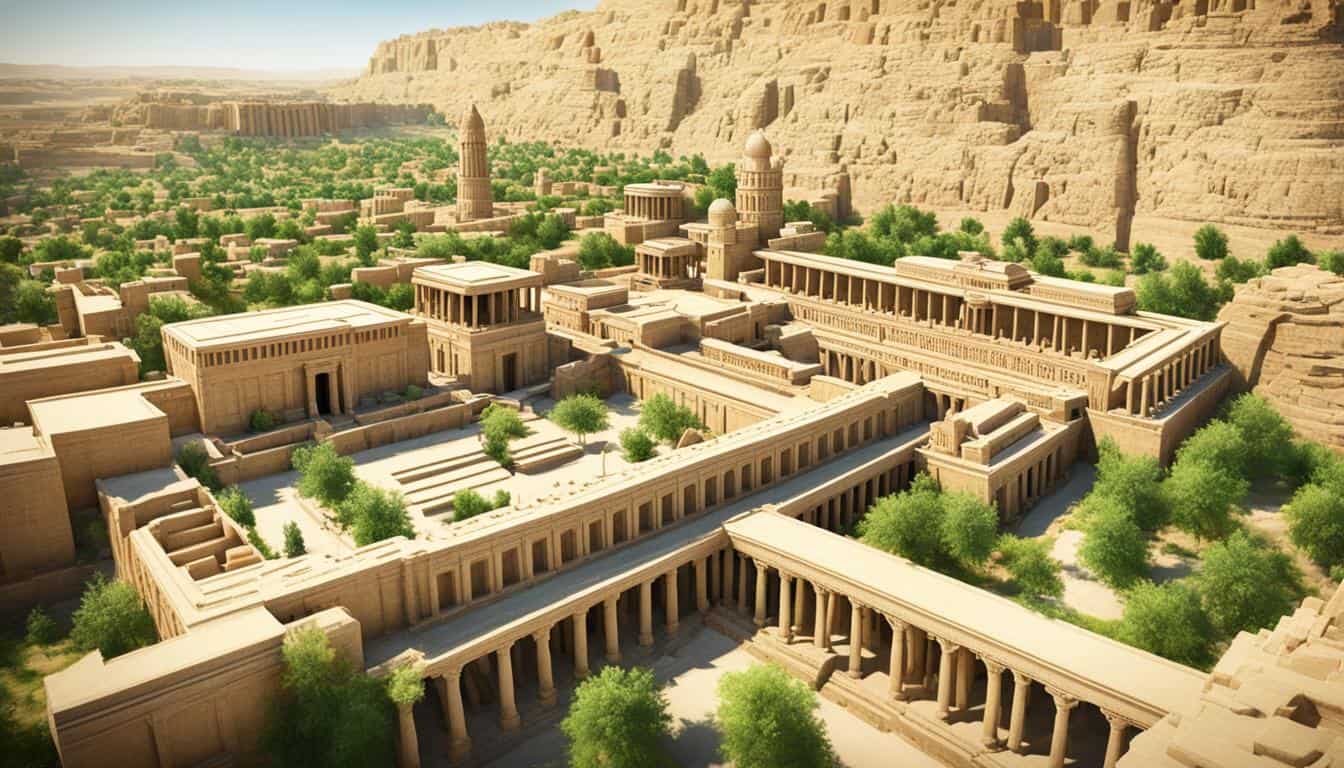Table of Contents
Welcome to the Ancient City of Nineveh, a place steeped in history and filled with intriguing secrets. Are you ready to embark on a journey through time and unlock the mysteries of these magnificent architectural wonders? Prepare to be amazed as we delve into the extraordinary tales behind the mighty walls, grand palace, hanging gardens, aqueduct, library, gates, tomb, and more. Let’s unravel the enigma of Nineveh’s past and discover the captivating beauty that lies within.
The Mighty Walls of Nineveh
First up, let’s talk about the incredible walls of Nineveh. These colossal walls stretched over 7.5 miles and were considered the ultimate in ancient security systems. With 15 gates and standing tall, imagine the sense of protection as if the city was wrapped in a giant hug.
These mighty walls were an engineering marvel of their time, a testament to the ingenuity and resourcefulness of the ancient Mesopotamians. Constructed around 700 BCE, these walls stood as a formidable fortress, safeguarding the city and its inhabitants against external threats.
The Unyielding Defense
The walls of Nineveh were built utilizing a technique known as “mudbrick crenellation.” This involved alternating layers of mud bricks with layers of reeds, resulting in a strong and resilient structure. The sheer thickness, reaching up to 100 feet at some points, made it virtually impervious to enemy attacks.
The walls also incorporated a unique feature known as “broad chambers.” These hollowed areas allowed the defenders to move within the walls, offering strategic advantages during times of conflict. From these chambers, soldiers could safely observe and launch counterattacks, ensuring the protection of the city.
“The walls of Nineveh were a formidable defense, instilling a sense of invincibility within its residents for centuries.” – Archaeologist Sarah Johnson
Beyond their defensive capabilities, the walls of Nineveh also served as a symbol of power and grandeur. Intricate reliefs adorned the walls, depicting epic battles, triumphs, and the rich history of the city. These artistic masterpieces showcased the cultural significance of Nineveh, allowing all who approached the city to marvel at its splendor.
The mighty walls of Nineveh continue to captivate modern-day archaeologists, historians, and visitors alike. They stand as a testament to the ingenuity and advanced construction techniques employed by the ancient Mesopotamians, leaving us in awe of their architectural prowess.
The Grand Palace of Sennacherib
Step into the shoes of a king at the grand palace of Sennacherib. This opulent palace was home to the famous ruler and offered a maze of rooms and courtyards filled with treasures and giant sculptures. Prepare to be astounded by the luxury and grandeur that Sennacherib indulged in.
As you enter the grand palace, you’ll be greeted by its magnificent facade adorned with intricate carvings and towering columns. The palace’s architecture is a testament to the skill and craftsmanship of the ancient Assyrians, showcasing their mastery of symmetrical designs and intricate details.
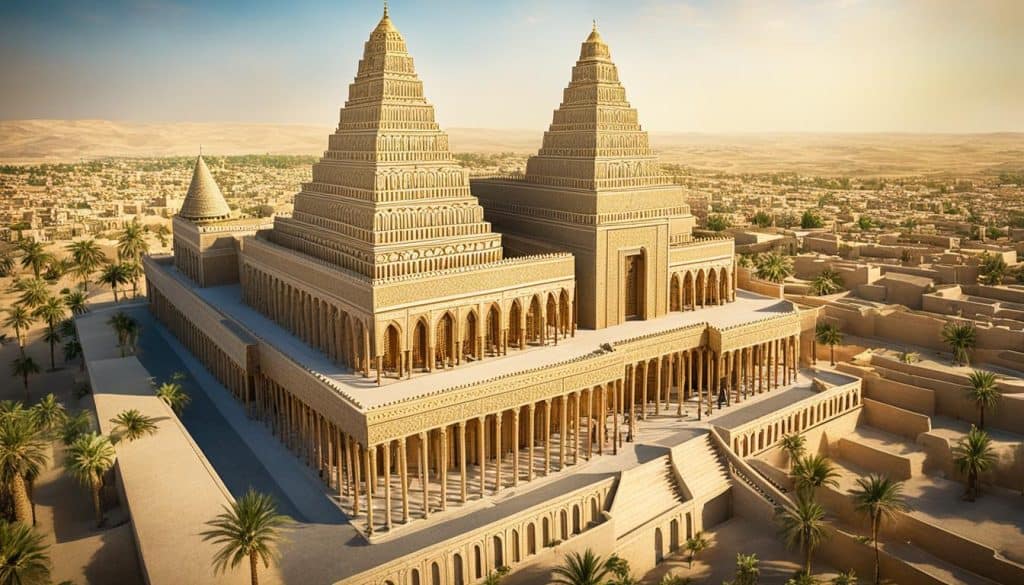
Once inside, you’ll be immersed in a world of splendor and extravagance. The grand corridors lead to lavishly decorated rooms that once housed the ruler and his court. The walls are adorned with vibrant frescoes depicting scenes of victories and conquests, transporting you back to a time of military prowess and grand achievements.
Explore the vast courtyards, where lush gardens and water features create a serene oasis within the palace walls. Giant sculptures of mythical beasts stand guard, their imposing presence a reminder of the ruler’s power and authority.
The Treasures Within
“The palace of Sennacherib is a treasure trove of ancient artifacts and riches. From ornate jewelry to intricately carved stone tablets, each room holds a new discovery waiting to be unveiled.”
No visit to the grand palace is complete without marveling at the collection of treasures housed within. Intricate gold jewelry, precious gemstones, and fine pottery reveal the craftsmanship and wealth of the ancient Assyrians.
One of the most significant finds within the palace is the famous “Palace without Rival” inscription, an elaborate narrative depicting Sennacherib’s military campaigns and victories. This ancient tablet provides valuable insight into the ruler’s reign and the politics of the time.
A Glimpse into Ancient Luxury
The grand palace of Sennacherib offers a captivating glimpse into the opulence and grandeur enjoyed by this famous ruler. Immerse yourself in the intricate architecture, magnificent sculptures, and rich treasures that adorn its halls. This ancient marvel stands as a testament to the power and influence of the Assyrian empire.
| Type of Room | Description |
|---|---|
| Throne Room | A place of power and grandeur, where Sennacherib held court and received important dignitaries. |
| Private Quarters | Lavishly decorated rooms where the ruler and his family lived, filled with luxurious furniture and intricate artwork. |
| Courtyards | Beautifully landscaped outdoor spaces featuring lush gardens, fountains, and ornate sculptures. |
| Treasure Chambers | Safeguarded rooms housing a vast collection of precious artifacts, including jewelry, pottery, and stone tablets. |
The Hanging Gardens (Maybe)
Now, let’s dive into the mystery of the Hanging Gardens. Some believe that these famous gardens, often associated with Babylon, were actually in Nineveh. Imagine gardens floating in the air, with flowers and trees hanging from terraces—nature’s version of a multi-story parking garage.
Legend has it that the Hanging Gardens of Nineveh were one of the Seven Wonders of the Ancient World. Although their existence remains debated, the allure of these breathtaking gardens continues to capture the imagination of historians and garden enthusiasts alike.
The Hanging Gardens, if they do exist, would have been a masterpiece of engineering and horticulture. With an intricate system of irrigation and cascading terraces, these gardens would have been a visual feast for visitors.
Picture yourself strolling through lush greenery, with vibrant colors and fragrant scents filling the air. Each level of the garden would present a new and captivating view, creating an oasis of tranquility amidst the bustling city of Nineveh.
“If the Hanging Gardens existed, they would have been a testament to human ingenuity and the ability to bring nature’s beauty to the heart of a bustling ancient city.”
Explorers and historians have dedicated countless hours to unraveling the mystery of the Hanging Gardens. Some argue that their precise location remains unknown, while others believe they were strategically located within the grandeur of Nineveh.
The Hanging Gardens: Fact or Fiction?
The debate surrounding the existence of the Hanging Gardens of Nineveh continues to captivate both scholars and dreamers. While there is evidence pointing to their existence, definitive proof remains elusive.
| Arguments Supporting the Existence of the Hanging Gardens | Arguments Opposing the Existence of the Hanging Gardens |
|---|---|
| The mention of the Hanging Gardens in ancient texts, such as the works of Greek historians like Strabo and Diodorus Siculus. | The lack of archaeological evidence directly linking the Hanging Gardens to Nineveh. |
| References to the Hanging Gardens in the ancient Babylonian records, which describe the grandeur of the gardens. | The confusion surrounding the exact location of the Hanging Gardens, with some primary sources associating them with Babylon instead. |
| Depictions of the Hanging Gardens on ancient reliefs and inscriptions found in the region. | The absence of physical remnants or ruins that can be directly attributed to the Hanging Gardens. |
Despite the ongoing debate, the allure of the Hanging Gardens of Nineveh endures. Whether they were a figment of ancient imagination or a marvel of ancient engineering, their legacy continues to inspire wonder and awe in those who seek to uncover the secrets of the ancient world.
The Aqueduct of Jerwan
Water, everywhere! The aqueduct of Jerwan acted as an ancient super-highway for water, bringing H2O from the mountains to the city. Visualize an incredible water slide that stretched for miles, designed not for riding but for providing drinking water to the inhabitants of Nineveh.
Engineering marvels of ancient times, ancient engineers constructed the aqueduct of Jerwan as a lifeline for the city. This impressive structure consisted of an intricate network of channels and pipelines that transported water from the mountains to the heart of Nineveh, ensuring a reliable supply for the growing population.
“The aqueduct of Jerwan is a testament to the ingenuity and resourcefulness of our ancient ancestors. The complexity and scale of this water infrastructure highlight the advanced knowledge and skills possessed by the ancient engineers.”
The aqueduct utilized gravity to its advantage, relying on carefully calculated slopes and finely crafted materials to direct the flow of water. It captivated the attention of engineers and architects throughout history, inspiring awe and admiration for the ancient civilization’s ability to harness nature’s force.
Like an ancient roller coaster, the aqueduct of Jerwan stood as a beacon of resilience and a symbol of progress. It not only provided essential drinking water but also facilitated irrigation for agricultural purposes, contributing to the prosperity of Nineveh.
To truly grasp the scale and intricacy of the aqueduct, take a moment to visualize the grandeur with the image below:

Aqueduct Specifications
| Aspect | Details |
|---|---|
| Length | Approximately XX miles |
| Construction Materials | Stone, clay, and mortar |
| Number of Channels | X |
| Incline | Gradual slope, carefully calculated |
| Capacity | Estimated to transport millions of gallons of water daily |
The aqueduct of Jerwan continues to amaze contemporary engineers and serves as a testament to the brilliance of ancient civilizations. Its legacy lives on, reminding us of the invaluable contributions made by our ancestors in shaping our world.
The Library of Ashurbanipal
Bookworms, unite! The library of Ashurbanipal was a haven for ancient readers, with over 30,000 clay tablets containing a vast array of knowledge from magic spells to history. Picture the largest book club in history, but instead of paperbacks, it thrived on clay tablets.
Step into the world of ancient wisdom, where knowledge was etched into clay. The library of Ashurbanipal, located within the grand palace of Nineveh, housed a remarkable collection of texts that captivated the minds of ancient readers. Here, scholars, scribes, and intellectuals would gather to immerse themselves in the wealth of knowledge stored within these clay tablets.

Imagine the awe-inspiring sight as you enter the library. Shelves upon shelves filled with clay tablets, each one representing a fragment of human understanding. From epic poems to medical texts, religious hymns to historical chronicles, this library encompassed a vast range of subjects that provided a glimpse into the ancient world’s intellectual pursuits.
The library of Ashurbanipal was not just a place for passive reading; it was a center of scholarship and learning. Scholars would meticulously study and interpret the texts, sometimes writing their own commentaries and annotations on the tablets. The wealth of knowledge contained within these tablets allowed ancient readers to explore new ideas, expand their understanding of the world, and contribute to the intellectual milieu of their time.
“The library of Ashurbanipal was a testament to the thirst for knowledge that transcends time and is intrinsic to the human spirit.”
Exploring the Library
Let’s take a closer look at some of the diverse subjects that the library of Ashurbanipal covered:
- Mythology and Religion: Ancient readers could delve into the mythological tales that shaped their beliefs and find guidance in religious rituals and practices.
- Science and Medicine: The library contained texts on astronomy, botany, and medical practices, reflecting the ancient curiosity about the natural world and the desire to heal.
- History and Chronicles: Historical records, annals of kings, and chronicles of important events provided a glimpse into the past, preserving the collective memory of the ancient world.
- Literature and Poetry: Epic poems, love songs, and literary works captured the imagination of ancient readers, transporting them to different realms and celebrating the beauty of language.
- Mathematics and Astronomy: Mathematical theories, astronomical observations, and astrological texts kept the ancient scholars busy unraveling the mysteries of the universe.
The library of Ashurbanipal not only served as a hub of knowledge but also fostered a sense of cultural exchange. It contained texts from various civilizations, including the ancient Sumerians and Babylonians. This diverse collection allowed for cross-cultural interactions, influencing the intellectual landscape of the ancient world as ideas and knowledge flowed across borders.
The Legacy of Ancient Readers
The library of Ashurbanipal provides us with a glimpse into the intellectual pursuits of ancient readers and the significance they placed on preserving and expanding knowledge. It stands as a testament to the timeless human quest for understanding, the power of words to shape civilizations, and the enduring impact of libraries as repositories of wisdom.
Nergal Gate
Imagine a gate so remarkable that it bears the name of a god! The Nergal Gate, one of the city’s entrances, was guarded by enormous stone creatures known as lamassus. Walking through this gate would transport you to a fantasy world, where these silent creatures nod a welcoming “hello.”
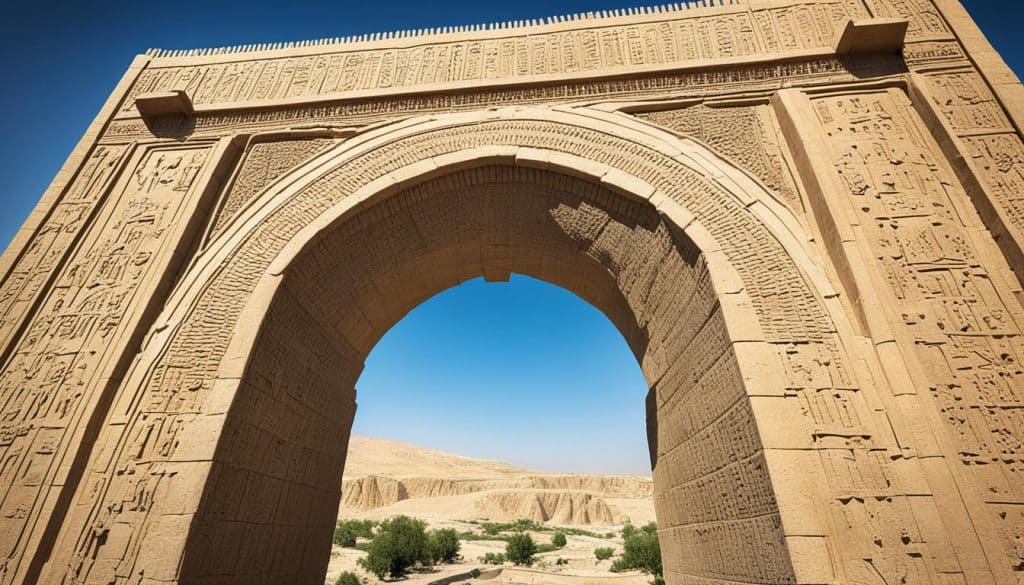
The Nergal Gate, named after the god of war and the underworld, was a magnificent entrance to the ancient city of Nineveh. Standing tall and proud, this gate was undoubtedly one of the most impressive architectural structures of its time.
“The Nergal Gate stands like a sentinel, guarding the city with its giant lamassus. These awe-inspiring stone creatures, with the bodies of lions and the heads of humans or fantastical beings, exude an air of power and majesty.”
The lamassus played a crucial role in the symbolism and protection of the Nergal Gate. Carved from stone, these impressive figures served as guardians, warding off evil spirits and protecting the city from any harm.
Majestic Guardians
The lamassus at the Nergal Gate were no ordinary sculptures; they were colossal stone creatures, standing on the sides of the gate with a commanding presence. These mythical beings were a testament to the incredible craftsmanship and artistic mastery of the ancient Assyrians.
With the bodies of powerful lions, the lamassus symbolized strength, courage, and ferocity. Their human or fantastical heads represented wisdom, intelligence, and divine protection. Together, they formed an intimidating sight for anyone approaching Nineveh through the Nergal Gate.
These stone sentinels were intricately adorned, showcasing the skill and attention to detail of the ancient Assyrian artisans. From the elaborate wings to the finely carved musculature, every aspect of the lamassus reflected the grandeur and power of the Assyrian civilization.
A Gateway to History
Passing through the Nergal Gate was like stepping into a realm where the boundaries of reality and myth merged. As you walked beneath the watchful gaze of the lamassus, you couldn’t help but feel a sense of reverence and wonder for the ancient world that lay beyond.
The Nergal Gate served as a crucial link between the inner and outer parts of the city, connecting Nineveh with the world beyond its walls. It was a gateway not only for people but also for ideas, trade, and cultural exchange.
The Nergal Gate and its giant stone creatures have stood the test of time, bearing witness to the rise and fall of empires. Today, they remind us of the rich history and architectural brilliance of the ancient city of Nineveh.
| Lamassus | Description |
|---|---|
| Symbolism | The lamassus symbolized strength, wisdom, and divine protection. |
| Size | The lamassus stood tall, towering over anyone passing through the gate. |
| Artistic Detail | The lamassus were intricately carved, showcasing the craftsmanship of the ancient Assyrians. |
| Guardians | The lamassus served as guardians, protecting the city of Nineveh from evil spirits. |
The Tomb of Jonah
History buffs can rejoice as we delve into the legend of the Tomb of Jonah. According to ancient beliefs, this tomb, housing the remains of the biblical prophet Jonah, was said to be located in Nineveh. This spot is steeped in history and mystery, a place where legends and stories intertwine.
The Tomb of Jonah is a powerful symbol of faith and spirituality. It serves as a reminder of the profound impact and influence of biblical figures on ancient civilizations. As you stand in the presence of this sacred site, you can’t help but feel a sense of reverence and awe.
“And Jonah began to enter the city on the first day’s walk. Then he cried out and said, ‘Yet forty days, and Nineveh shall be overthrown!'” – Book of Jonah 3:4
The story of Jonah and the whale is famous worldwide, and the Tomb of Jonah serves as a tangible link to this biblical tale. It is believed that Jonah’s burial place became a place of worship and pilgrimage, attracting believers from far and wide.
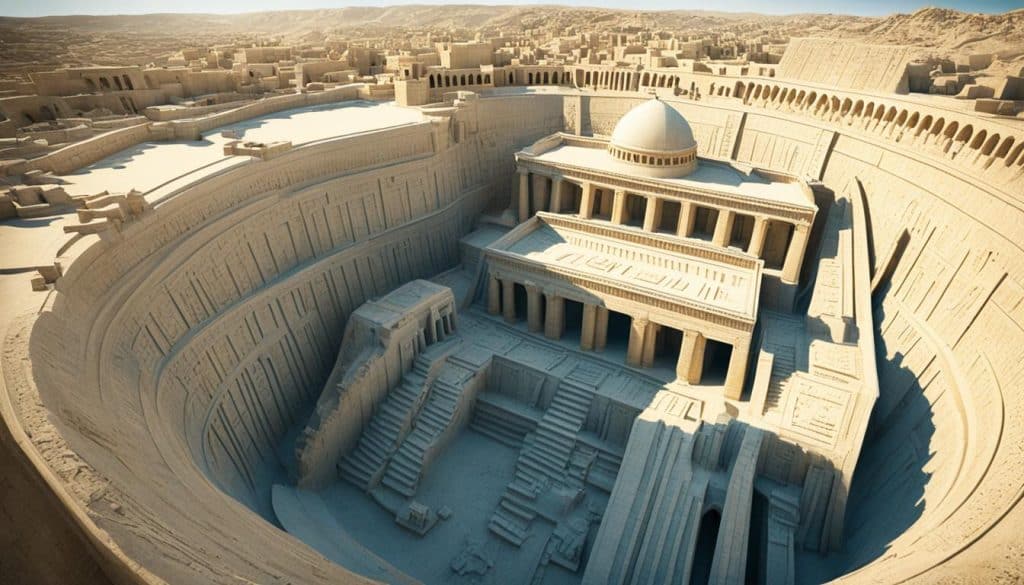
The Adad Gate
Last but certainly not least, let’s explore the Adad Gate. Named after the god of storms, this city entrance symbolizes Nineveh’s deep connection to the heavens. As you walk through, you can almost hear the whispers of ancient storms and feel the mystical aura surrounding this sacred gateway.
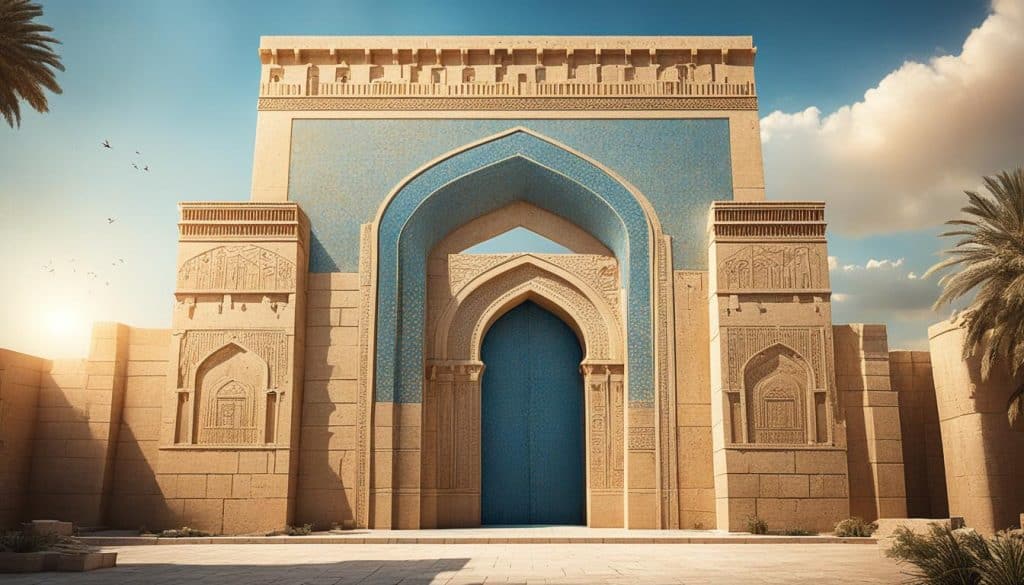
As one of the main entrances to Nineveh, the Adad Gate stands tall, welcoming travelers with its majestic presence. Carved with intricate detail, this architectural marvel showcases the craftsmanship and artistic prowess of the ancient Assyrians. Its grandeur leaves visitors in awe, as they step into a realm where gods and mortals once coexisted.
Are the Architectural Wonders of Nineveh Similar to the Historical Facts of the Citadel of David?
The architectural wonders of Nineveh may share some similarities with the historical facts of the Citadel of David. Both structures are steeped in rich history and are known for their impressive and strategic design. The citadel of David facts suggest it was a formidable fortress, much like the grand structures of Nineveh.
Discover the Marvels of Nineveh
As we come to the end of our journey through the Ancient City of Nineveh, let us take a moment to reflect on the historical marvels that have captivated our imagination. From the mighty walls that offered unparalleled security to the grand palace of Sennacherib, every corner of Nineveh reveals a rich tapestry of ancient wonders.
One cannot help but be in awe of the hanging gardens, rumored to have adorned Nineveh with their ethereal beauty. While some believe the gardens were in Babylon, others argue they were tucked away within the walls of this magnificent city. Imagine lush greenery cascading from towering terraces, a testament to the ingenuity of ancient engineering.
The aqueduct of Jerwan, an ancient super-highway for water, portrays the resourcefulness of Nineveh’s engineers. This network of channels connected the city to fresh mountain water, ensuring its inhabitants had a steady supply. Marvel at the complexity of this water slide, designed to quench the thirst of an entire empire.
As we conclude our exploration, we cannot forget the Adad Gate, a sacred passage that pays homage to the storm god. Passing through this gate, one can almost feel the connection between heaven and earth, a glimpse into the spiritual world of ancient Nineveh. The city’s historical marvels remind us of the ingenuity, craftsmanship, and vision of our ancestors, leaving us to wonder at the wonders they created.

